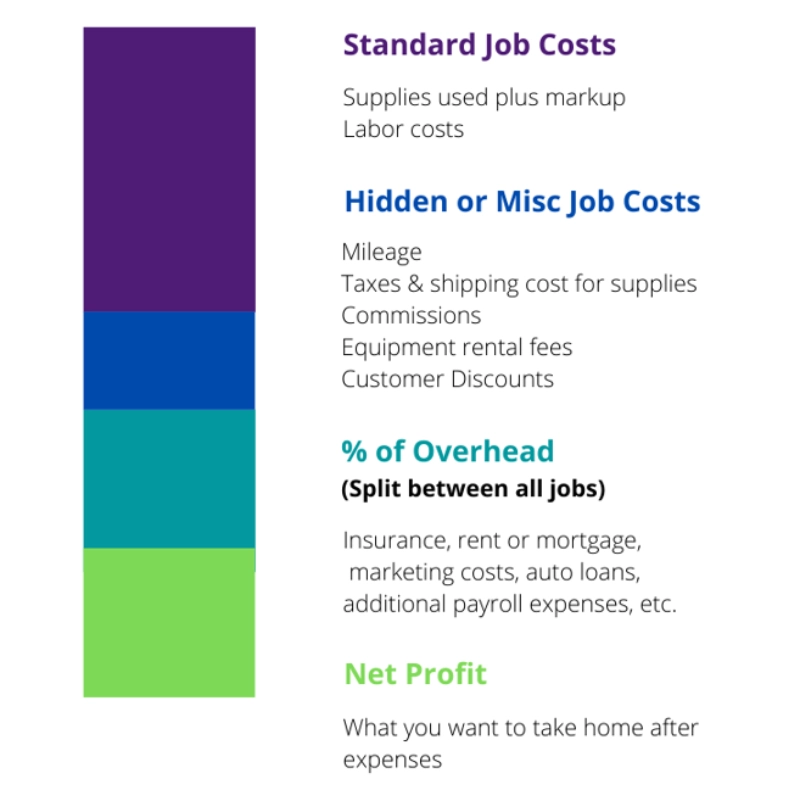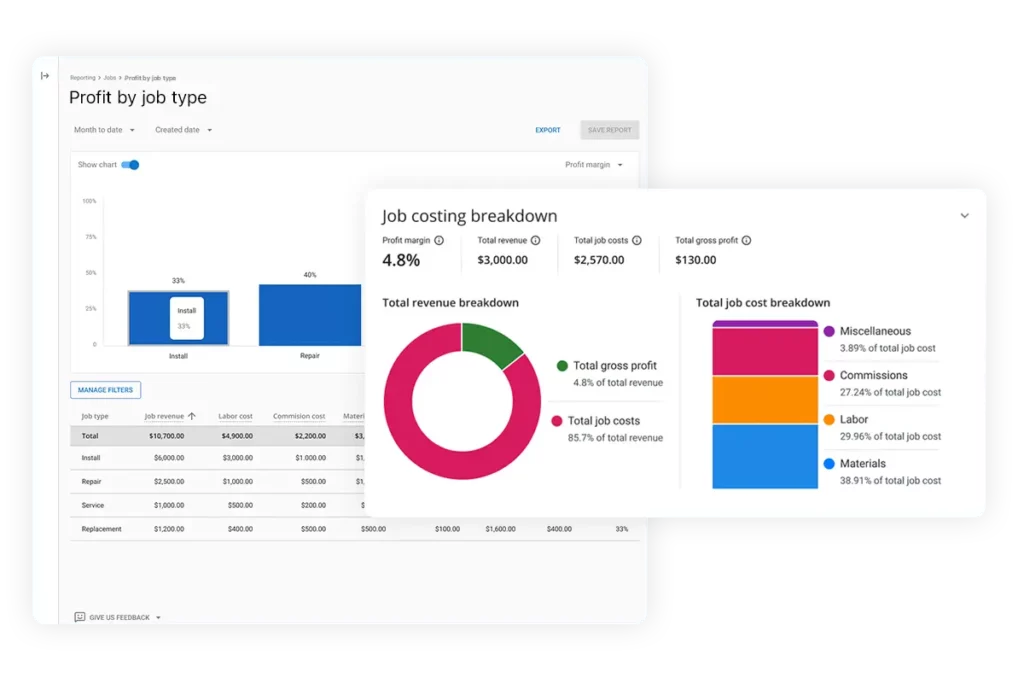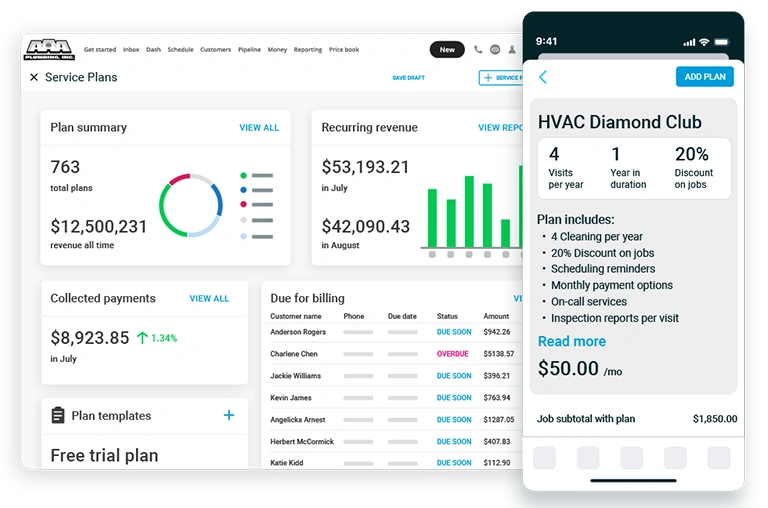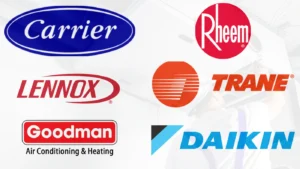Want to win more jobs with less effort?
Grow your business and send quick quotes with our home service software.

HVAC work is steady, but running a profitable business takes more than maintaining a full schedule. Turning that work into true profitability means understanding costs, pricing properly, and building steady cash flow.
Whether you’re just starting an HVAC business or looking to level up, this guide breaks down the strategies to build a truly profitable HVAC company. We’ll cover how to set the right prices, bring in more leads, build recurring revenue, streamline operations, invest in your team, and track the numbers that matter most. You’ll also get tips from the following experts:
- Irena Martincevic, an industry analyst for the home services platform Fixr.com.
- Jensen Savage, the CEO and founder of Savage Growth Partners, a full-service marketing firm for service businesses.
- Ken Goodrich, chairman of Goettl Air Conditioning & Plumbing.
How to make money in the HVAC business:
- Step 1: Track costs
- Step 2: Understand your profit levers
- Step 3: Price HVAC services for profitability
- Step 4: Increase leads with smart HVAC marketing strategies
- Step 5: Build recurring revenue with maintenance and upsells
- Step 6: Streamline operations to save time and money
- Step 7: Invest in your team
- Step 8: Track metrics that matter
- Step 9: Scale with financing and growth investments
- How Housecall Pro can help
Step 1: Track costs
Profitability isn’t just about how much money comes in; it’s about what you keep after paying all your expenses. According to the U.S. Department of Energy, healthy HVAC businesses typically see a 12% net margin. This means they keep 12 cents out of every dollar the business earns, so if they bring in $100,000 in revenue, they’d have about $12,000 left as profit.
Business owners can fall below this benchmark when they only focus labor and materials and don’t track other expenses closely. “Add in vehicle upkeep, insurance, training, marketing, software, lead generation…If you don’t account for all of it, you’ll be leaking money without realizing it,” Martincevic says.

Here are some common costs to track beyond labor and materials:
- Business insurance: Liability, workers’ comp, and equipment coverage
- Marketing and lead generation: Ads, SEO, and referral programs
- Office and admin costs: Rent, utilities, supplies, and phone systems
- Payroll and benefits: Wages, overtime, health insurance, retirement contributions
- Software and tools: Scheduling, invoicing, and project management systems
- Training and certifications: Ongoing education for technicians and staff
- Vehicle expenses: Fuel, maintenance, repairs, and fleet insurance
Step 2: Understand your profit levers
Tracking costs is just the first step. To truly understand profitability, you need to track what jobs bring in the most money and what parts of your business are most profitable. This will help you make smarter decisions about pricing, services, and business growth.
Follow these steps:
- Track profit per job or service: Some jobs have higher labor, travel, or material costs, which can eat into margins. Break down each job by labor hours, materials used, travel time, and any subcontractor costs. Compare that to the revenue charged to see which types of jobs are truly profitable.
- Monitor customer profitability: Certain clients may cost more in time, discounts, or service calls than they generate in revenue. Keep a simple record of recurring clients and track the total profit they bring in over time. Consider adjusting pricing, minimum service charges, or even your service approach for low-profit clients.
- Analyze trends over time: Review monthly or quarterly reports to identify which services, teams, or territories consistently generate the best margins. Use this data to optimize scheduling, pricing, and staff assignments.
- Use software to simplify tracking: Tools like Housecall Pro can assign costs to each job, calculate net profit automatically, and highlight the most profitable areas of your business.
Step 3: Price HVAC services for profitability
Pricing is where profitability starts. Many HVAC companies set their rates by blindly matching what competitors charge, but that often leads to underpricing. Just because another company charges $100 for a service call doesn’t mean that price covers your expenses—or that it reflects the quality of your work.
“A smarter play is value-based pricing, where you set your rates based on what it actually costs to run your business and the value you bring,” Martincevic says.
Follow these steps to price your HVAC services for maximum profit:
- Calculate your total cost per job.
This includes:
- Direct labor (hours x hourly wage, including payroll taxes and benefits)
- Parts and materials
- Travel costs (fuel, vehicle wear, etc.)
- Overhead (insurance, software, marketing, rent, admin costs, etc.)
- Apply markup.
For example, let’s say a capacitor replacement costs you $150 all-in. You might add a 50% markup (a fairly standard number, especially for replacement and repair parts). With that markup ($75), you’ll charge $225. This price ensures you cover all of your costs and leave room for profit.
- Check your margin using this formula, or plug your numbers into our HVAC profit margin calculator for faster math:
Margin = (Price – Cost) / Price
So, using the example above: ($225 – $150) / $225 = 0.33
Multiply that number by 100 to get a percentage, and you have a 33% margin. That’s above the typical range for a healthy HVAC business.
- Remember the difference between markup and margin
- Markup is what you add to your costs to set the price.
- Margin is the profit you actually keep from that price.
Both matter, but margin shows the true profitability of the job.

To make pricing even easier, here are some practical tips you can implement right away:
- Use job costing software: Quickly see profitability on every service without manual calculations
- Adjust prices if costs rise: Don’t just absorb the hit.
- Choose your positioning: Decide whether you’ll position yourself as budget-friendly, premium, or somewhere in the middle.
- Review your pricing regularly: Seasonal changes, supply costs, and labor rates can affect profitability.
- Communicate value to customers: Explain the quality, experience, and service they’re getting to justify your rates.
Step 4: Increase leads with smart HVAC marketing strategies
Profitability depends on steady leads. Thankfully, you don’t need a massive budget to generate them. Start with what you can and expand as your budget grows, focusing on the channels that put you in front of your target customers when they’re most likely to book.
“Google Ads and SEO are hands-down the most consistent drivers of high-quality leads for HVAC businesses because they catch people at the moment of intent,” Savage says. ”When someone types in ‘AC repair near me’ or ‘furnace install in Chicago,’ they’re actively seeking a solution to a problem.”
Your marketing efforts help capture that intent, turning searchers into customers. Here’s a closer look at how that works.
Learn more: HVAC marketing strategies & ideas to get more customers
Local SEO basics
Over 75% of consumers look up companies online before visiting them, so your website and online presence need to make a good first impression. Strong HVAC SEO helps you show up when people search for your services near them. Start here:
- Build out your Google Business Profile with updated photos, hours, and service. This helps you showcase credibility..
- Encourage reviews after every job. Customers trust word of mouth, and a steady stream of positive reviews will boost your rankings.
- Add city- or neighborhood-specific keywords to your site to show up in local searches (think “furnace repair in Denver” instead of just “furnace repair”).
Paid ads and referrals
Paid ads can deliver leads fast, and referrals keep them coming back long-term. Both should work hand in hand. Here are some best practices for HVAC pros:
- Run Google Ads targeting high-intent searches like “AC repair near me” or “HVAC emergency service” to catch people who are ready to book.
- Track every campaign with unique phone numbers or QR codes so you know what’s working.
- Offer and actively promote referral bonuses—these often convert better than cold ads.
Step 5: Build recurring revenue with maintenance and upsells
One-off HVAC jobs can help pay the bills, but maintenance plans turn those customers into recurring revenue. They also open the door to upsells that raise your average ticket size.

Here are a few popular upsells that fit naturally into service calls:
- Duct cleaning that improves air quality and system performance
- Extended labor warranties that reassure customers and set you apart
- Indoor air quality add-ons like air filters or purifiers
- Smart thermostats that boost efficiency and convenience
The benefit here isn’t just bigger invoices; it’s loyalty. Customers who sign up for recurring service plans are far more likely to call you for installs, repairs, and upgrades down the road. Tools like Housecall Pro make it easy to set up and manage recurring service plans, track customer subscriptions, and automate billing, so you can spend more time delivering great service while keeping revenue steady.
Free download: HVAC maintenance contract template
Get In Touch: 858-842-5746
Let us earn your trust
On average, Pros increase monthly revenue generated through Housecall Pro by 50% after their first year.
See plan options and feature breakdown on our pricing page.
Step 6: Streamline operations to save time and money
Every inefficiency chips away at profit. For most HVAC companies, the money drains in a few places:
- Scheduling: Manual calendars lead to overlaps and missed opportunities.
- Dispatching: Without visibility into where techs are, you waste drive time.
- No-shows: A single missed appointment leaves hours of lost revenue.
Automating the admin side with HVAC software like Housecall Pro helps smooth out these common issues. That means more jobs per day and one less thing on the never-ending to-do list.
Step 7: Invest in your team
As a business owner, your HVAC technicians are the face of your business and the ones driving your revenue forward. A well-trained, motivated team headed by strong leadership can make all the difference between scraping by and hitting strong margins.
Here are a few ways to invest in your team effectively:
- Training: Daily technical and customer service training reduces mistakes, boosts efficiency, and increases upsell opportunities.
- Tools: When you have reliable equipment, your techs can work faster and safer with fewer callbacks.
- Incentives: Add bonuses or recognition for upsells, efficiency, or customer reviews. This can go a long way in motivating your team and boosting your bottom line.
- Career paths: Teach techs where they can grow in your business. How can they advance? Having that room for opportunity helps reduce turnover and build loyalty.
- Culture: Set clear expectations and maintain a supportive environment. Both can encourage consistent, professional performance.
“Our business is basically a trade school. We train every day—not just on technical skills, but how to communicate, upsell, handle objections, everything,” Goodrich says. “Trained people do better work, faster. Fewer mistakes, better results, more revenue. That’s where profit comes from.”
Additional resources:
- E-book: The Ultimate Guide to Hiring Leadership
- Download: HVAC employment application template
Step 8: Track metrics that matter
It’s tough to improve what you don’t measure. Don’t just rely on gut instinct. Monitor these numbers:
- Revenue per job: Helps you see which types of jobs are most profitable so you can push higher-revenue services.
- Cost per lead: Tracks how much you spend on marketing or advertising to get a potential customer so you can identify which channels give the best return on investment.
- Customer lifetime value (CLV): Tracks the long-term value of maintenance contracts and repeat clients.
The payoff is clarity. If a lead channel is attracting high-cost, low-revenue jobs, focus on channels that attract higher-value customers or tweak your messaging to better qualify leads before they book. If certain customers consistently spend more over time, consider targeting similar clients or offering them maintenance plans and upsells.
Pro tip: Use Housecall Pro’s Advanced Reporting to track these metrics automatically. You can see which jobs, clients, and channels are most profitable, giving you clear, data-driven insights to grow your business and maximize profits.
Step 9: Scale with financing and growth investments
Once your net margin is strong and you’re consistently booked out, it’s time to grow your HVAC business. This might mean adding a new technician, investing in another service vehicle, or offering new services like duct cleaning or commercial contracts.
Here are some signs it’s time to scale:
- You’re turning away work: If your schedule is consistently full, new jobs are opportunities you’re leaving on the table.
- Your net margin is healthy and sustainable: Make sure your profits can support hiring, equipment purchases, or marketing for growth.
- You have systems in place: Efficient scheduling, dispatch, billing, and reporting processes ensure you can manage a larger team and more jobs without chaos.
The next step is planning how to scale effectively. Follow these steps:
- Evaluate financing options: Consider small business loans or lines of credit to fund vehicles, tools, or additional staff.
- Hire strategically: Bring on technicians or office staff who complement your existing team and can help maintain service quality.
- Test new services gradually: Start with one or two additions, track profitability, and expand once they’re proven to be profitable.
Scaling is about controlled growth—investing wisely in people, equipment, and services so your business can handle more work while maintaining healthy profits.
How Housecall Pro can help you make money
The most profitable HVAC businesses run on systems, not just hustle. Housecall Pro is designed to help HVAC companies like yours run more efficiently. Our software combines scheduling, invoicing, marketing, and reporting in a single platform so you can spend more time growing your business and less time on admin.
With Housecall Pro, you can:
- Send professional proposals, estimates, and invoices in minutes
- Automate reminders to reduce no-shows
- Easily track employee hours
- Track job costs and profitability in real time
- Build recurring revenue with service plans
- Manage your team’s schedules and time tracking
The result is less busywork, more completed jobs, and clearer visibility into what’s actually driving your profits. Start our free 14-day trial today to start building a business that’s busy and profitable.






